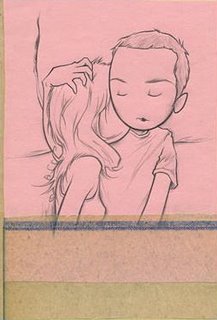Here's an essay I wrote for the wonderful Ken Nolley. I'm really proud of it, actually. Warning: disturbing descriptions of the effects of atomic radiation. CU = close-up, etc. Also, don't even think about stealing this. I will have my minions hunt you down. And besides, your teacher knows you don't write like this anyway ;-)
Lisa C. Smith
11/28/2003
Vis. Evidence
Prof. Nolley
The Image/Sound Relationship in Shots 97-116 of
Hiroshima/Nagasaki, August 1945
Over this semester, I have developed an appreciation for the documentary film form, and I now consider the films we have watched to be valuable additions to anyone’s education. A few, however, I consider important enough that every citizen of the world should see them. Hiroshima/Nagasaki, August 1945 is one of these essential films. The suffering of people in war and specifically in atomic war serves as a powerful reminder and warning we must heed. In Hiroshima/ Nagasaki, August 1945, the most moving and disturbing images are the shots toward the end of the film that document “human effects”. However, in shots 97-116 there is a great disconnect between the narration and the footage shown.
Footage Narration
97. MCU from left of man’s face as “And on the fourteenth day, as they
a bandage is removed, revealing stood before their mirrors, burns. women saw their hair come out in handfuls in their combs.”
98. MCU from left of side of head.
A hand is cleaning a burned ear.
99. CU of baby. “Hospitals filled with new patients who . . .”
100. CU of bald child turned away “. . . had not seemed sick before. on bed, head at left. Hypodermic They were vomiting, bleeding from administered, child shakes. the gums, . . . “
101. Doctor checks supine child with “. . . and purple spots appeared on stethoscope – shot from feet of child. their skin. Some could not be touched because their skin slipped off. . .”
102. MCU of a child, head turned left, “. . . in huge, glove-like pieces. At mouth opening and closing as hands first they were quarantined, tap his chest. considered victims . . .”
103. MS of child from the back. Hands “. . . of a mysterious infectious are dabbing at sores on back; head is illness. Gradually it was bald and also covered in sores. understood . . ."
104. CU on child facing camera; hands “. . . that the disease was radiation place a bandage of left side of face. sickness, and these people the special victims . . .”
105. MS of child and doctor, child “. . . of the atomic bomb.”
sitting with leg pulled up as doctor
works on hip and legs.
106. MCU of compresses being placed
on the feet of little girl.
107. CU doctor dabbing at stumps of
fingers of girl’s hand. Drops cotton,
picks up something else with sticks.
108. MCU of feet pointed right. “And by the twentieth day . . .”
109. CU from above of what seems “ . . . after the bomb, vegetation to be a burned foot. began to grow wildly . . .”
110. CU of terribly burned leg at “. . . in the wreckage of the cities. charred knee with fly walking on it. From remnants of plants lush green . . .”
111. CU of burned foot. ". . . weeds and wildflowers sprang again, madly . . .”
112. XCU of hand dabbing at shin “. . . in extraordinary with cotton. regeneration stimulated by atomic radiation . . .”
113. XCU of burned hand with “. . . and as people died of compress on it. radiation sickness, the cities were blanketed with flowers.”
114. XCU of hands dabbing at
burned hand and stumps of
fingers; turn hand over.
115. CU Two healthy hands hold
thin, weak arm and hand, turn it
over and back, hand flexes.
116. XCU at same angle as 115 of
badly burned hand. TONE changes . . .
These shots are preceded by narration that is closely linked to the shots and followed by more human effects shots accompanied only by music. I personally cannot doubt either the truth of the spoken descriptions or the visible evidence in 97-116, and I do not believe that this disconnect undermines the trustworthiness of the film. Still, the overlay of shots with unrelated (or distantly related) narration in this section does have interesting effects. This device allows information not documented in the footage to be included in the film, permits the use of maximum impact footage with indirectly related appalling descriptions, and to a certain extent confounds the viewer.
Much of the suffering caused by the detonation of Little Boy and Fat Man was not recorded in Akira Iwasaki’s footage, which eventually provided the bulk of the shots used in Hiroshima/ Nagasaki, August 1945. In shot 97, for example, we see a bandage being peeled away from burns on a man’s face at the same time as the narrator describes women losing their hair due to radiation poisoning. The image before us and the spoken words are not directly related; instead of discussion of radiation burns, or even injuries of another man, we hear of the hair loss of multiple women in a distinct setting, “before their mirrors”, with a specific prop, “combs”. This contrasts sharply with the earlier tone of the piece where image and narration were generally closely related, as with the kimono burns shots and narration in 92-93.
It seems that the Columbia team wanted to include descriptions of those effects of the atom bomb that were not covered in Iwasaki’s footage by describing them in the narration. Many of the people who experienced the most dramatic effects were dead by the time Iwasaki’s crew reached the cities almost a month after the bombs were dropped (342, Iwasaki). Thus, their suffering could no longer be documented on film and only oral reports were available to Barnouw and his associates in the making of the film. They included these effects in the narration of shots 97-116. Barnouw states in “The Hirsoshima/ Nagasaki Footage: a Report” that “Survivors on the outer fringes of the havoc were photographed in improvised treatment centers” (92). Note that the footage of people that Iwasaki’s team shot, in addition to being many days belated, was of people who had escaped not only instant death but who were also capable of getting to or being moved to a treatment center on the fringes of the city. Given the horrors we see here, what on earth must it have been like in the midst of “the havoc”? We get some idea of this appalling suffering in the narration of injuries and effects not shown, coupled with intensely emotional images.
Shots 99 – 107 are all of children, and this series of shots has a strong impact on the audience because almost all of us have a strong affinity and affection for children. These images are surrounded by close-ups on burned faces, hands and feet. Without having access to all of the footage originally shot by Iwasaki’s team it is impossible to know how much of it was used by the Columbia team. According to Barnouw’s discussions with Akira Iwasaki in “Iwasaki and the Occupied Screen”, however, there was not much “human” footage shot, and I expect that we do see most of the shots available. Akira Iwasaki’s and his team’s choice to shoot children and hands informs our understanding of what they considered important to record, and I believe their choices represent those things which we all recognize as human and sacred: children, hands, faces, and eyes. To see a suffering child, a burned face, and hands without fingers is to know the human horror that the detonation of the atom bombs caused. By coupling these high impact and intensely human shots with the appalling narration of other atomic effects, the filmmakers generated a more intense and emotional response to both in the audience.
In particular, the shot choice of 113, 114, 115, and 116 is artful, if the word can be conscientiously used in this context. These shots conclude the section of disconnected narration and shots and lead in to the human effects and music. First there is shot 113, of a compress on a burned hand, next shot 114 of a terribly burned hand with only stumps of fingers remaining, and then in shot 115 we see a weak and yet normal appearing forearm and hand, with the hand opening and closing, being held by two normal hands and arms, followed by shot 116 of yet another badly burned hand. Placing the shot of the relatively normal hand and forearm in the middle along with the health worker’s arms reminds us of what a hand should look like and how it should move. The burned hands following have a renewed horror they would have lost if we had only seen a series of badly burned hands; it is easy to become numb to horror. Instead, we take each of the images to heart, and bear the full weight of their meaning.
I carefully chose the verb “confound” to describe the effect that the distinct narration and shots have on the viewer. This device not so much confuses as overpowers. At the same time as we try madly to deal with the pictures our imaginations conjure up of “vomiting and bleeding from the gums” (shot 100) and “skin [that] slipped off in huge glove like pieces” (shots 101-2), our eyes send the image of a shaking child receiving a shot (100) and two other clearly ill children being examined (shots 101-2) to our brain. Visual or auditory alone would have been enough to inspire a strong emotional response, but together they overwhelm us. It is easy to imagine that these children, or others like them, suffered such effects. The attempt to communicate the magnitude and horror of the effects of the atom bomb on humans is well served here, for just as in watching this film we find we cannot comprehend the whole, so the reality must have been. Little pieces stay with us, and attached to the shot that we cannot dismiss is the memory of unfathomable other images, even those we never saw onscreen but only imagined, based on the narration.
Of course, this is what Hiroshima/ Nagasaki, August 1945 does so well: it records and presents that which we must not forget. Of the concluding shots of human effects, from about 90 on, it can truly be said that “every frame [is] burned into [our] brain[s]” (Iwasaki, 342). But with this comes an undeniable danger, the chance that in the strength of our emotional response we will fail to think. There is nothing more dangerous than an action done or a word spoken in passion. When situations are highly charged emotionally, we lose our ability to analyze. And yet, it is those deeds and speeches that awaken feeling in us which should be most closely examined. If we allow ourselves to be driven strictly by emotion, then we respond and act in an instinctual manner, and fail to use the reasoning powers that make us human. In the ongoing quest to understand ourselves, there can be nothing more worthwhile than knowing what we care about, what we weep for – and why.
Works Cited:
Barnouw, Erik. “The Hiroshima-Nagaskai Footage: a Report”. Historical Journal of Film, Radio and Television, Vol. 2, No. 1, 1982: 91-100.
Barnouw, Erik. “Iwasaki and the Occupied Screen”. Film History, Vol. 2, 1988: 337-357.
Prof. Kenneth Nolley’s original shot lists, discussions and support also made this work possible. (I wasn’t sure how to credit you – hope this works!)




















